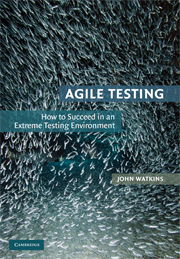Book contents
- Frontmatter
- Contents
- Foreword by Bob Bartlett
- Acknowledgments
- 1 Introduction
- PART 1 REVIEW OF OLD-SCHOOL AND AGILE APPROACHES
- PART 2 EVERYONE IS DIFFERENT: AGILE CASE STUDIES
- 4 From Waterfall to Evolutionary Development and Test
- 5 How to Test a System That Is Never Finished
- 6 Implementing an Agile Testing Approach
- 7 Agile Testing in a Remote or Virtual Desktop Environment
- 8 Testing a Derivatives Trading System in an Uncooperative Environment
- 9 A Mixed Approach to System Development and Testing: Parallel Agile and Waterfall Approach Streams within a Single Project
- 10 Agile Migration and Testing of a Large-Scale Financial System
- 11 Agile Testing with Mock Objects: A CAST-Based Approach
- 12 Agile Testing – Learning from Your Own Mistakes
- 13 Agile: The Emperor's New Test Plan?
- 14 The Power of Continuous Integration Builds and Agile Development
- 15 The Payoffs and Perils of Offshored Agile Projects
- 16 The Basic Rules of Quality and Management Still Apply to Agile
- 17 Test-Infecting a Development Team
- 18 Agile Success Through Test Automation: An eXtreme Approach
- 19 Talking, Saying, and Listening: Communication in Agile Teams
- 20 Very-Small-Scale Agile Development and Testing of a Wiki
- 21 Agile Special Tactics: SOA Projects
- 22 The Agile Test-Driven Methodology Experiment
- 23 When Is a Scrum Not a Scrum?
- PART 3 AGILE MY WAY: A PROPOSAL FOR YOUR OWN AGILE TEST PROCESS
- APPENDIX A The Principles of Rapid Application Development
- APPENDIX B The Rules and Practices of Extreme Programming
- Appendix C The Principles of the Dynamic Systems Development Method
- Appendix D The Practices of Scrum
- APPENDIX E Agile Test Script Template
- Appendix F Agile Test Result Record Form Template
- Appendix G Agile Test Summary Report Template
- Appendix H My Agile Process Checklist
- References
- Index
18 - Agile Success Through Test Automation: An eXtreme Approach
Published online by Cambridge University Press: 26 October 2009
- Frontmatter
- Contents
- Foreword by Bob Bartlett
- Acknowledgments
- 1 Introduction
- PART 1 REVIEW OF OLD-SCHOOL AND AGILE APPROACHES
- PART 2 EVERYONE IS DIFFERENT: AGILE CASE STUDIES
- 4 From Waterfall to Evolutionary Development and Test
- 5 How to Test a System That Is Never Finished
- 6 Implementing an Agile Testing Approach
- 7 Agile Testing in a Remote or Virtual Desktop Environment
- 8 Testing a Derivatives Trading System in an Uncooperative Environment
- 9 A Mixed Approach to System Development and Testing: Parallel Agile and Waterfall Approach Streams within a Single Project
- 10 Agile Migration and Testing of a Large-Scale Financial System
- 11 Agile Testing with Mock Objects: A CAST-Based Approach
- 12 Agile Testing – Learning from Your Own Mistakes
- 13 Agile: The Emperor's New Test Plan?
- 14 The Power of Continuous Integration Builds and Agile Development
- 15 The Payoffs and Perils of Offshored Agile Projects
- 16 The Basic Rules of Quality and Management Still Apply to Agile
- 17 Test-Infecting a Development Team
- 18 Agile Success Through Test Automation: An eXtreme Approach
- 19 Talking, Saying, and Listening: Communication in Agile Teams
- 20 Very-Small-Scale Agile Development and Testing of a Wiki
- 21 Agile Special Tactics: SOA Projects
- 22 The Agile Test-Driven Methodology Experiment
- 23 When Is a Scrum Not a Scrum?
- PART 3 AGILE MY WAY: A PROPOSAL FOR YOUR OWN AGILE TEST PROCESS
- APPENDIX A The Principles of Rapid Application Development
- APPENDIX B The Rules and Practices of Extreme Programming
- Appendix C The Principles of the Dynamic Systems Development Method
- Appendix D The Practices of Scrum
- APPENDIX E Agile Test Script Template
- Appendix F Agile Test Result Record Form Template
- Appendix G Agile Test Summary Report Template
- Appendix H My Agile Process Checklist
- References
- Index
Summary
SYNOPSIS
“Automation, Automation, Automation” was the battle cry of our leaders as we embarked on our first “iterative” mission with a large team of twenty testers; within our agile iterative test approach, we have invested heavily in test automation, unit test, and continual integration.
After a number of years of operating this strategy, we had reached a point where the regression test took up to ten days to run through (35,000 tests), and we had to create an approach we called “laser-guided testing” to pinpoint the best set of tests to run each build. We can now run a complete targeted regression in less than a day!
We saw many benefits of our agile automated approach, but there are costs and pitfalls that are worth considering ahead of time.
Introduction
My name is Jon Tilt; I have been involved in software development for twenty-five years and specifically in software testing since 1996. I started testing in the functional test team of MQSeries, a large middleware product. Since then I have progressed through test management, test project lead, and test architect roles. I currently work for IBM's Software Group under the WebSphere brand and am the Chief Test Architect across a number of Enterprise Service Bus (ESB) products that generate in excess of one billion dollars of revenue each year. The products we deliver are primarily enterprise middleware offerings (application servers, messaging backbones, etc.) that many major Fortune 500 companies bet their businesses on.
- Type
- Chapter
- Information
- Agile TestingHow to Succeed in an Extreme Testing Environment, pp. 132 - 138Publisher: Cambridge University PressPrint publication year: 2009



